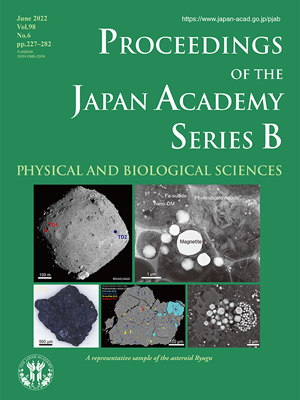About the Cover
Vol. 98 No. 6 (2022)
The Hayabusa sample return missions represent a great achievement for the Japanese space program as well as for planetary science, revealing the surface characteristics of several different classes of asteroid and elucidating the key processes that formed and shaped the Solar System. The first Hayabusa mission returned a limited number of 10s-µm-sized samples from the S-type asteroid Itokawa in 2010. The Hayabusa2 mission collected and returned a total of ~5.2 g of sample from two localities on the C-type asteroid Ryugu to Earth in 2020. Preliminary infrared spectroscopy indicated that all the samples contained organic matter and water.
The article in the current issue (pp. 227-282) presents a comprehensive analysis and detailed observations of Ryugu samples. Multi-scale petrography was conducted for inorganic and organic materials, and elemental, isotopic and chronological data were obtained. Here the appearance of a Ryugu particle (A0033, TD1 site) at the mm to nm scale is demonstrated. Top left — Ryugu. The TD1 locality sourced materials from the surface of Ryugu, while the TD2 locality sourced material from the subsurface. Bottom left — The Ryugu particle has a rough, irregular surface, and is finely cracked, resulting in its fragile nature. It appears very dark to the naked eye, and contains light-colored components, which are often exposed on the surface. Bottom middle — The particle is also composed of µm- to nm-sized voids, µm-sized coarse components (various colors), and a nm-sized phyllosilicate-dominated matrix (grey color). In conjunction the above characteristics yield the particles low bulk density and high porosity. Bottom right — The coarse components in the particle are often represented in multiple domains, comprising various minerals with different crystal habits. These features are some of the most crucial pieces of evidence that help to reveal the origin and evolution of Ryugu and its progenitor. Top right — A high resolution image of the particle demonstrates that the µm-sized magnetite, dolomite, and phyllosilicate nodules, and the nm-sized organic matter (OM) and iron-sulfides are widespread in the matrix. These features and the analytical information obtained from them, indicate that Ryugu has preserved some of the most primitive materials found so far within the solar system. Moreover, these materials shed light on the origin and evolution of the solar system and the organic chemistry that originated the building blocks of life.
Ikuo Kushiro
Member of the Japan Academy




